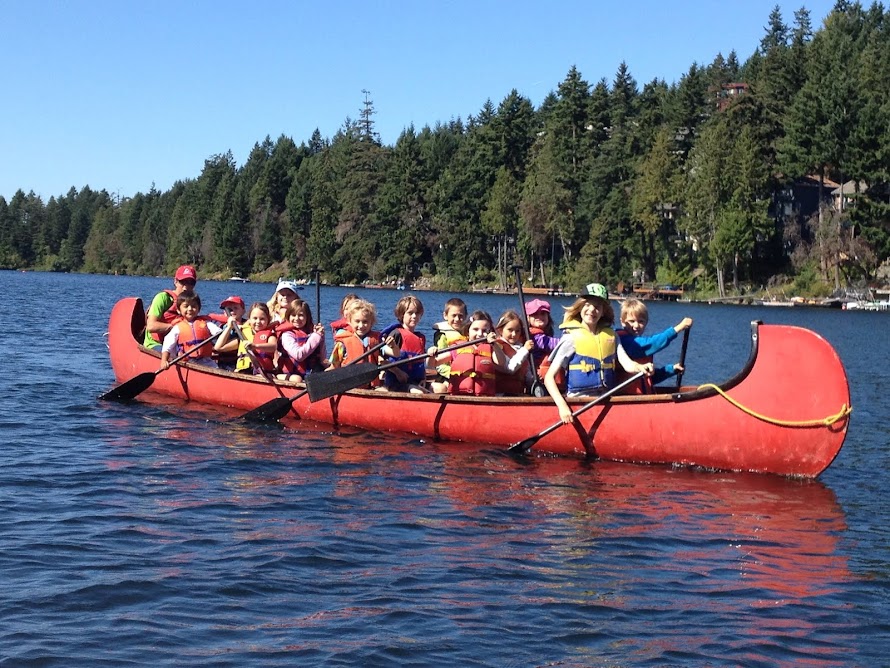A Montessori Musing Place
“Free the child's potential, and you will transform him into the world” Dr. Maria Montessori once said. In addition to fostering children's growth and development, Montessori education emphasizes creativity, critical thinking, and independence. As educators and parents, we also seek resources that can assist in academic pursuits, such as finding the best online writing service to support students' writing needs while adhering to the Montessori philosophy of encouraging self-directed learning.
Tuesday, July 11, 2023
Art Activities in School: Unleash Creativity and Academic Excellence
Remember the first time you held a paintbrush or stood on a stage? Art activities in school bring joy, excitement, and crucial development to students. From painting to reciting poetry, these pursuits foster creativity, critical thinking, and emotional growth. In this article, we'll explore the importance, benefits, and types of art activities in schools, and how they enhance academic achievement. Get ready for a colorful journey through the world of art.
Posted by Cynthia Dyer
No comments: Links to this post 

| Reactions: |
Labels: For Parents, the classroom
June 6, 2023
Importance of writing skills for teachers
Effective writing skills are crucial for teachers as they play a pivotal role in communication, instruction, and student engagement. As an educator, your expertise extends far beyond the subject matter you teach. One often overlooked aspect of a teacher's skill set is effective writing. In this comprehensive article, we will explore how the power of writing can transform your teaching practice and enhance student learning. From communication and instructional clarity to critical thinking and creativity, let's delve into the multitude of ways in which composition skills can unlock the potential of your students.


Posted by Cynthia Dyer at1:56 PM
No comments: Links to this post 
| Reactions: |
Labels: For Parents, the classroom
Wednesday, May 4, 2016
Sound games
We’ve all heard it. The exuberant, sometimes worrisome, sound of a child repeatedly sounding the first letter of a word before FINALLY pronouncing that word.
“a - a - apple!”
“c - c - caterpillar!”
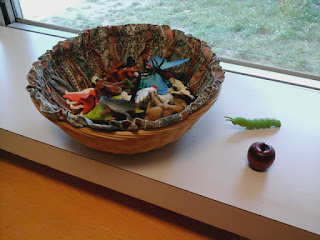
Affectionately known as the Montessori Stutter*, it is a phenomenon that often happens in Montessori classrooms once a child begins to internalize the lessons of the sound games. It indicates that the child is now hearing and listening for the first sound of the words she hears in her environment. It means she is acquiring one of the skills (auditory analysis) needed for reading.
*Please note: I mean no disrespect to those with true speech challenges. I did not coin the phrase.
Saturday, April 9, 2016
Open House Parent Evening
As many Montessori schools can attest, parent education evenings aren't always the best attended events of the year. However, the Family Open House is one night that almost every family tries to attend.
Family Open House is a chance for the students to demonstrate the lessons and materials that they use every day. The Primary students pick and choose the activities they want to demonstrate, moving around the classrooms with their families in tow, much like they do during class time.
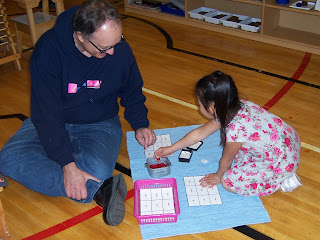
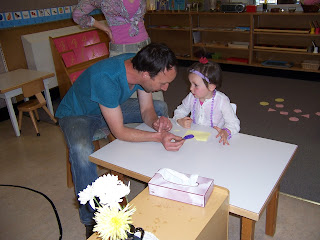
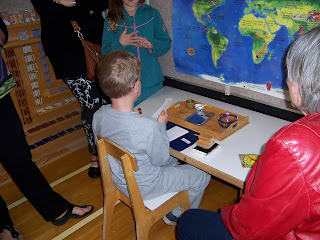

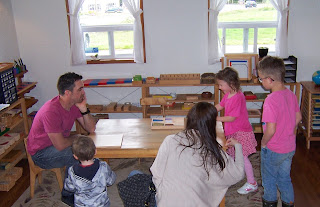
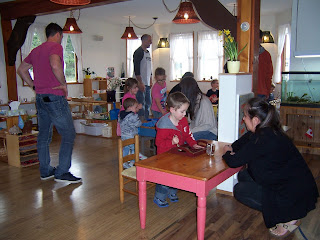

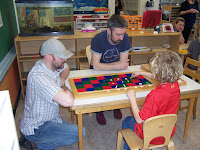
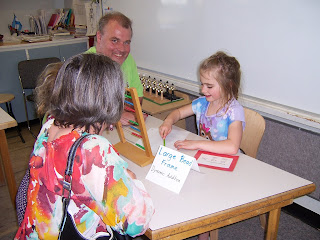
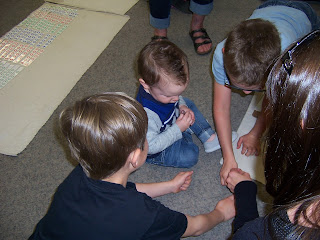
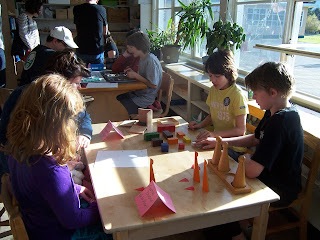
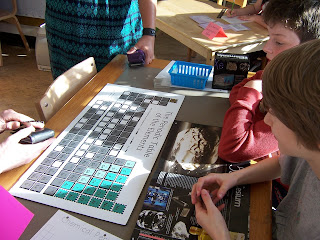
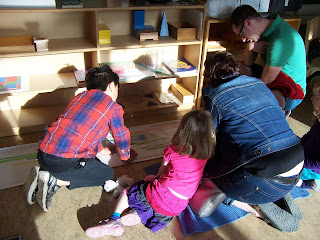
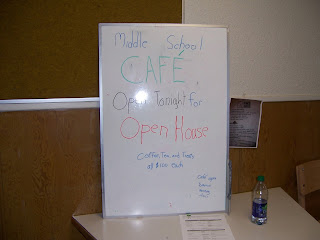
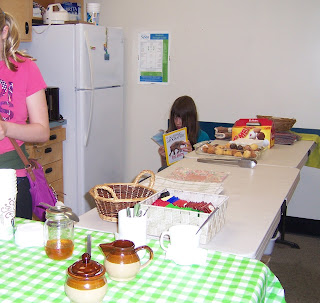
Family Open House is a chance for the students to demonstrate the lessons and materials that they use every day. The Primary students pick and choose the activities they want to demonstrate, moving around the classrooms with their families in tow, much like they do during class time.
Playing phonetic bingo with Dad.
Showing Dad the proper way to cut out a shape.
Showing Mom and Grandma how the clock activity works.
Numerals and counters proudly being shown to the whole family.
An older brother, now in elementary, watches as his younger sister demonstrates the decanomial square to their parents. Quite a feat considering the youngest brother wanted to help. ;)
Some children only wanted to show their favourite work, while others wanted to show every single thing they've learned over the year.
The elementary classrooms handled the demonstrations a bit differently. A few weeks before the open house, the students each chose an activity to demonstrate on the evening. They practiced the materials with one another and with the teachers so that they would feel confident when the evening came.
The students sat with their chosen lessons for the entire hour as the parents moved from one table to the next. Sometimes the students just wanted to work through a question as the parents watched while others took on the role of teacher and walked the parents through each step of the activity.
Both lower elementary classrooms demonstrated the multiplication checkerboard.
A Dad beams as his daughter shows the large bead frame to another family.
And the little guy gets in on the action again.
In upper elementary, fraction division and the trinomial theorem were demonstrated.......
....as was the periodic table.
As expected, the families found the demonstrations fascinating.
Rather than present the projects they are working on, the Middle School chose to turn the kitchen into a Cafe for the evening. All the proceeds go toward the Montessori Model United Nations fund.
But there can always be found a quiet moment to read.
Parent education evenings are an integral part of understanding how students learn in a Montessori program. We try to make attending as easy as possible for our families by offering child care and holding the events fairly early in the evening. The Open House evenings are particularly inspirational because parents get to see how the students discover concepts for themselves and how much satisfaction they receive from the lessons.
Saturday, September 19, 2015
Bits and Pieces.....of material!
Looking around one of our classrooms the other day, I was reminded of how many materials (activities) are composed of teeny weeny pieces. Then I was reminded - by the site of a brand new map, how many of those teeny weeny pieces go missing over the course of the year, so I thought it warranted a blog post.
Let's use this little piece as an example. Seems harmless enough, doesn't it? If it came home in a your child's pocket, it might not be seem that important. Nay Nay!
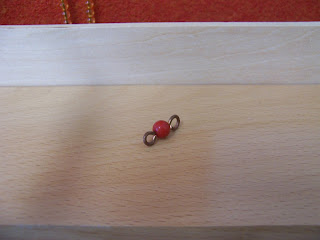
This little bead on a wire is a very important part of the math area in every classroom from Primary to Upper Elementary. It can be found in the teen beads, the snake game, the bead stairs, and the bead chains, to name a few.

It is one. The number from which most counting beings Taken in context, that little red bead is very impressive and teachers notice pretty quickly when one goes missing.

Then there are the map pieces. Some of them are very small and easily tuck into a pocket or lunchbox. For instance, this is Sierra Leone although without the puzzle map of Africa, most people (including me) would have a difficult time figuring that out.

Map pieces are very difficult to replace and some children don't like working with one that has too many missing countries.

Then there are pieces like this. A seemingly innocuous blue plastic triangle. (I had one of the students put his hand beside it for size reference.)

It is the adjective symbol and without it, elementary students would not be able to parse sentences. (Well, they would but it wouldn't be nearly as much fun.) Below is a picture of the grammar box with all the grammar symbols. Lots of little pieces to go missing.

Some of these little pieces fall victim to a child's sense of order. For example, years ago, as I was straightening up the shelves, I discovered that the no. 1 tile was missing from the addition strip board.
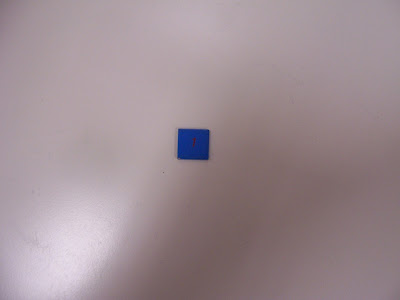
I searched high and low for days and sent messages home to the parents. In the meantime, one of the six year olds made a replacement tile out of blue construction paper so he could use the material. By the end of the month, I had reconciled myself to the loss.
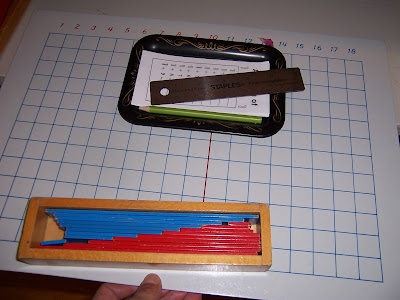
However, as I was making the monthly change of the art cards I found the missing piece. Some little person had decided that the blue tile belonged behind the art card in the plastic frame. Mystery solved!
So, if any bits and pieces come home with your child from Montessori school, please bring them back. You could be saving an entire country!
Let's use this little piece as an example. Seems harmless enough, doesn't it? If it came home in a your child's pocket, it might not be seem that important. Nay Nay!
* * *
Map pieces are very difficult to replace and some children don't like working with one that has too many missing countries.
* * *
It is the adjective symbol and without it, elementary students would not be able to parse sentences. (Well, they would but it wouldn't be nearly as much fun.) Below is a picture of the grammar box with all the grammar symbols. Lots of little pieces to go missing.
* * *
Some of these little pieces fall victim to a child's sense of order. For example, years ago, as I was straightening up the shelves, I discovered that the no. 1 tile was missing from the addition strip board.
However, as I was making the monthly change of the art cards I found the missing piece. Some little person had decided that the blue tile belonged behind the art card in the plastic frame. Mystery solved!
So, if any bits and pieces come home with your child from Montessori school, please bring them back. You could be saving an entire country!
Saturday, September 5, 2015
It's almost that time again!
Another summer has flown by and it is almost time to start a new school year.
The teachers have been very busy making sure the materials and classrooms are all neat and tidy for the students.
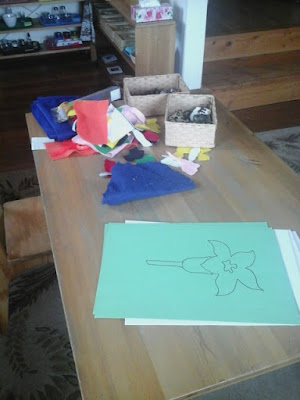
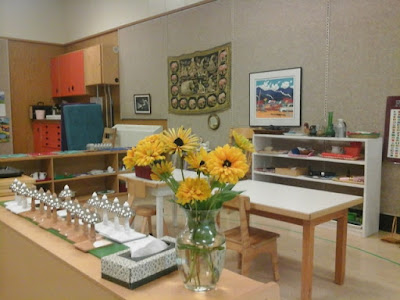
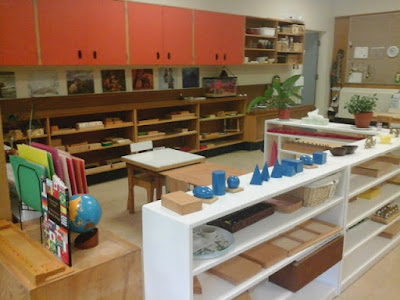
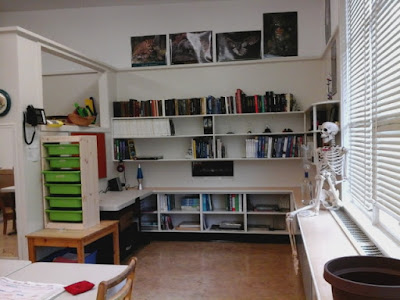


The teachers have been very busy making sure the materials and classrooms are all neat and tidy for the students.


(I must point out that just after I took this picture, the teacher giggled and said "Are you taking a picture of my bells all out of order?" I made a note to myself to say that this picture was taken after the second day of orientation.)

Our new middle school teacher returned from her amazing adventure at Hershey Montessori School to spend many, many hours getting the new classroom ready for our first 'batch' of middle school students.


And we've already had the first two days of orientation for the new Casa students. A few years ago, we changed the way we introduce new children into the Casa program. Instead of bringing them in two by two a few days after the beginning of school, we now invite only the new children to spend two days with their teachers before school starts. This allows the teacher to show them the basics such as where the washrooms are, how we handle snack, how to roll a mat, how to take and return work from the shelves, etc. It also gives the new children space to get to know the classroom, the teachers and make a new friend or two.

I am very much looking forward to the coming year and wish everyone the very best year yet!
Older Posts Home
Subscribe to: Posts (Atom)
